airbag VOLVO V60 2013 Owners Manual
[x] Cancel search | Manufacturer: VOLVO, Model Year: 2013, Model line: V60, Model: VOLVO V60 2013Pages: 422, PDF Size: 9.59 MB
Page 4 of 422
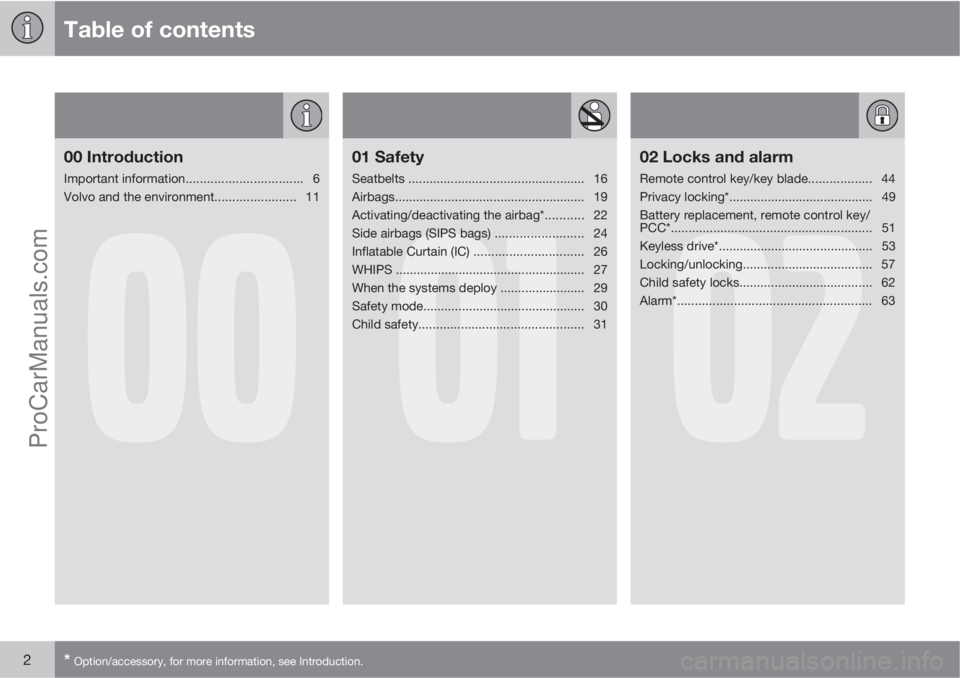
Table of contents
2* Option/accessory, for more information, see Introduction.
00
00 Introduction
Important information................................. 6
Volvo and the environment....................... 11
01
01 Safety
Seatbelts .................................................. 16
Airbags...................................................... 19
Activating/deactivating the airbag*........... 22
Side airbags (SIPS bags) ......................... 24
Inflatable Curtain (IC) ............................... 26
WHIPS ...................................................... 27
When the systems deploy ........................ 29
Safety mode.............................................. 30
Child safety............................................... 31
02
02 Locks and alarm
Remote control key/key blade.................. 44
Privacy locking*......................................... 49
Battery replacement, remote control key/
PCC*.........................................................51
Keyless drive*............................................ 53
Locking/unlocking..................................... 57
Child safety locks...................................... 62
Alarm*....................................................... 63
ProCarManuals.com
Page 16 of 422
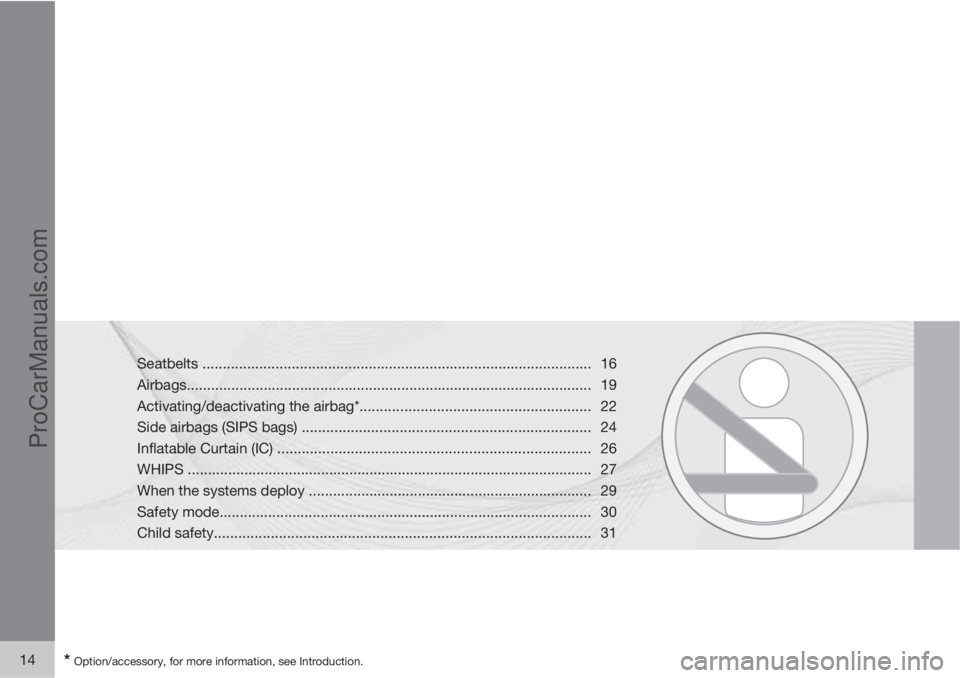
14* Option/accessory, for more information, see Introduction.
Seatbelts ................................................................................................ 16
Airbags.................................................................................................... 19
Activating/deactivating the airbag*......................................................... 22
Side airbags (SIPS bags) ....................................................................... 24
Inflatable Curtain (IC) ............................................................................. 26
WHIPS .................................................................................................... 27
When the systems deploy ...................................................................... 29
Safety mode............................................................................................ 30
Child safety............................................................................................. 31
ProCarManuals.com
Page 19 of 422
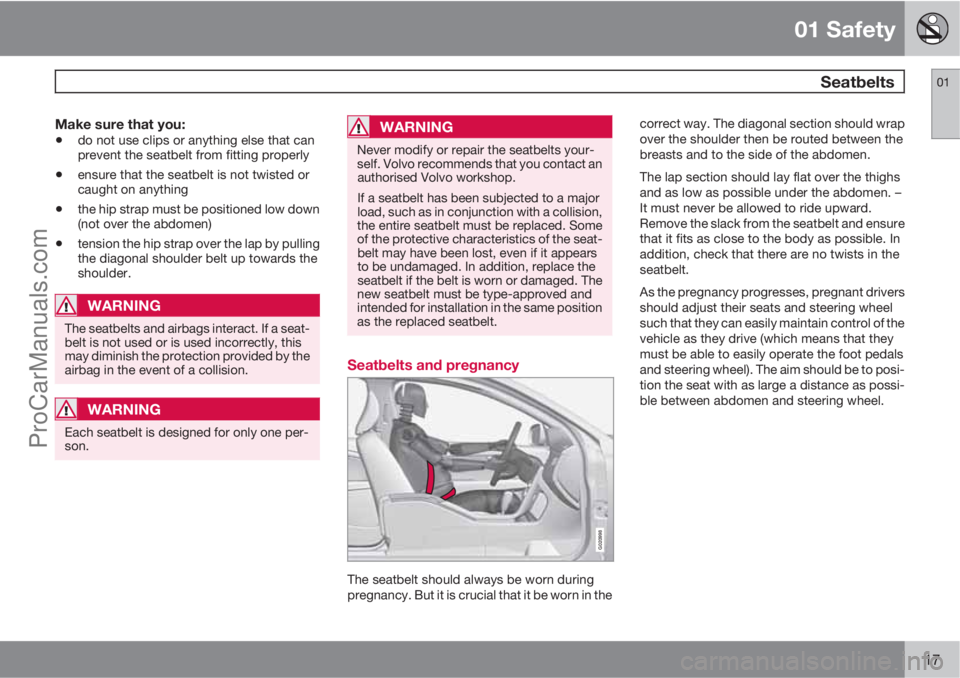
01 Safety
Seatbelts01
17
Make sure that you:
•do not use clips or anything else that can
prevent the seatbelt from fitting properly
•ensure that the seatbelt is not twisted or
caught on anything
•the hip strap must be positioned low down
(not over the abdomen)
•tension the hip strap over the lap by pulling
the diagonal shoulder belt up towards the
shoulder.
WARNING
The seatbelts and airbags interact. If a seat-
belt is not used or is used incorrectly, this
may diminish the protection provided by the
airbag in the event of a collision.
WARNING
Each seatbelt is designed for only one per-
son.
WARNING
Never modify or repair the seatbelts your-
self. Volvo recommends that you contact an
authorised Volvo workshop.
If a seatbelt has been subjected to a major
load, such as in conjunction with a collision,
the entire seatbelt must be replaced. Some
of the protective characteristics of the seat-
belt may have been lost, even if it appears
to be undamaged. In addition, replace the
seatbelt if the belt is worn or damaged. The
new seatbelt must be type-approved and
intended for installation in the same position
as the replaced seatbelt.
Seatbelts and pregnancy
G020998
The seatbelt should always be worn during
pregnancy. But it is crucial that it be worn in thecorrect way. The diagonal section should wrap
over the shoulder then be routed between the
breasts and to the side of the abdomen.
The lap section should lay flat over the thighs
and as low as possible under the abdomen. –
It must never be allowed to ride upward.
Remove the slack from the seatbelt and ensure
that it fits as close to the body as possible. In
addition, check that there are no twists in the
seatbelt.
As the pregnancy progresses, pregnant drivers
should adjust their seats and steering wheel
such that they can easily maintain control of the
vehicle as they drive (which means that they
must be able to easily operate the foot pedals
and steering wheel). The aim should be to posi-
tion the seat with as large a distance as possi-
ble between abdomen and steering wheel.
ProCarManuals.com
Page 21 of 422
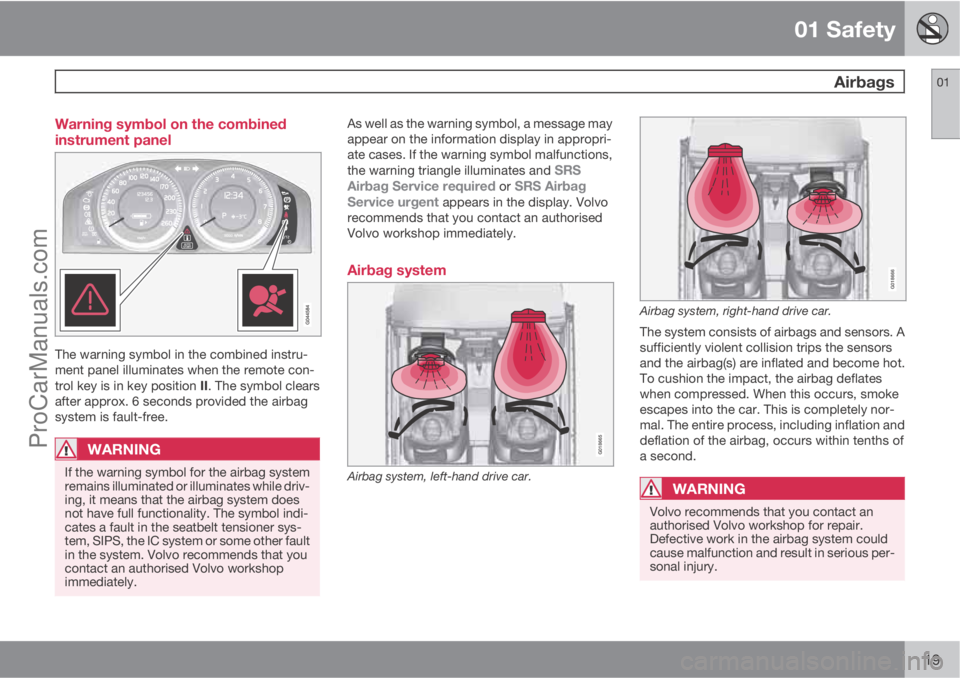
01 Safety
Airbags01
19 Warning symbol on the combined
instrument panel
The warning symbol in the combined instru-
ment panel illuminates when the remote con-
trol key is in key position II. The symbol clears
after approx. 6 seconds provided the airbag
system is fault-free.
WARNING
If the warning symbol for the airbag system
remains illuminated or illuminates while driv-
ing, it means that the airbag system does
not have full functionality. The symbol indi-
cates a fault in the seatbelt tensioner sys-
tem, SIPS, the IC system or some other fault
in the system. Volvo recommends that you
contact an authorised Volvo workshop
immediately.
As well as the warning symbol, a message may
appear on the information display in appropri-
ate cases. If the warning symbol malfunctions,
the warning triangle illuminates and
SRS
Airbag Service required or SRS Airbag
Service urgent appears in the display. Volvo
recommends that you contact an authorised
Volvo workshop immediately.
Airbag system
G018665
Airbag system, left-hand drive car.
G018666
Airbag system, right-hand drive car.
The system consists of airbags and sensors. A
sufficiently violent collision trips the sensors
and the airbag(s) are inflated and become hot.
To cushion the impact, the airbag deflates
when compressed. When this occurs, smoke
escapes into the car. This is completely nor-
mal. The entire process, including inflation and
deflation of the airbag, occurs within tenths of
a second.
WARNING
Volvo recommends that you contact an
authorised Volvo workshop for repair.
Defective work in the airbag system could
cause malfunction and result in serious per-
sonal injury.
ProCarManuals.com
Page 22 of 422
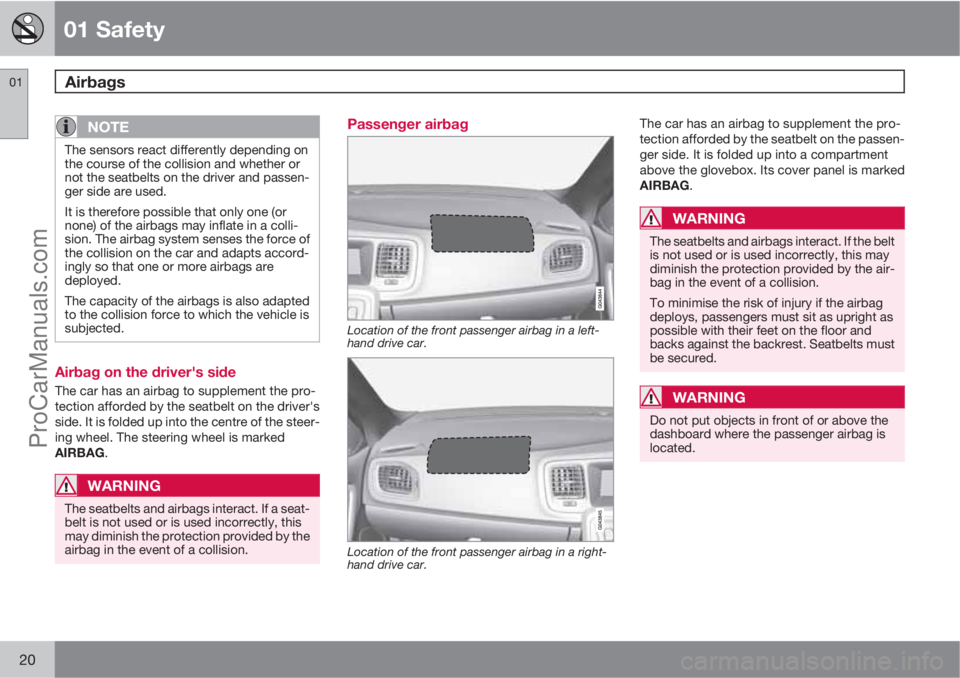
01 Safety
Airbags 01
20
NOTE
The sensors react differently depending on
the course of the collision and whether or
not the seatbelts on the driver and passen-
ger side are used.
It is therefore possible that only one (or
none) of the airbags may inflate in a colli-
sion. The airbag system senses the force of
the collision on the car and adapts accord-
ingly so that one or more airbags are
deployed.
The capacity of the airbags is also adapted
to the collision force to which the vehicle is
subjected.
Airbag on the driver's side
The car has an airbag to supplement the pro-
tection afforded by the seatbelt on the driver's
side. It is folded up into the centre of the steer-
ing wheel. The steering wheel is marked
AIRBAG.
WARNING
The seatbelts and airbags interact. If a seat-
belt is not used or is used incorrectly, this
may diminish the protection provided by the
airbag in the event of a collision.
Passenger airbag
Location of the front passenger airbag in a left-
hand drive car.
Location of the front passenger airbag in a right-
hand drive car.
The car has an airbag to supplement the pro-
tection afforded by the seatbelt on the passen-
ger side. It is folded up into a compartment
above the glovebox. Its cover panel is marked
AIRBAG.
WARNING
The seatbelts and airbags interact. If the belt
is not used or is used incorrectly, this may
diminish the protection provided by the air-
bag in the event of a collision.
To minimise the risk of injury if the airbag
deploys, passengers must sit as upright as
possible with their feet on the floor and
backs against the backrest. Seatbelts must
be secured.
WARNING
Do not put objects in front of or above the
dashboard where the passenger airbag is
located.
ProCarManuals.com
Page 23 of 422
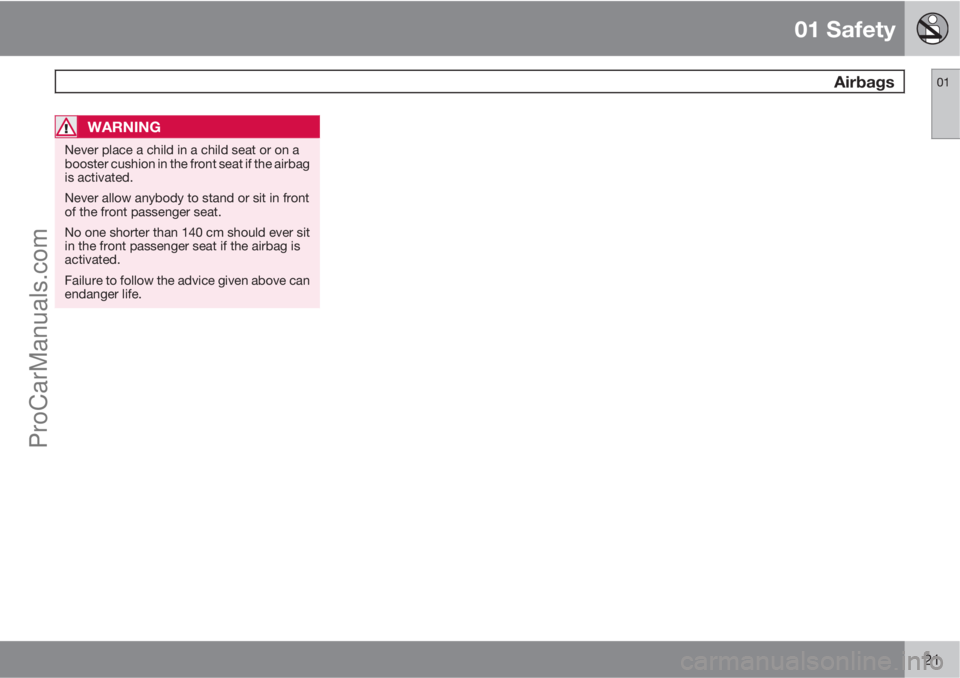
01 Safety
Airbags01
21
WARNING
Never place a child in a child seat or on a
booster cushion in the front seat if the airbag
is activated.
Never allow anybody to stand or sit in front
of the front passenger seat.
No one shorter than 140 cm should ever sit
in the front passenger seat if the airbag is
activated.
Failure to follow the advice given above can
endanger life.
ProCarManuals.com
Page 24 of 422
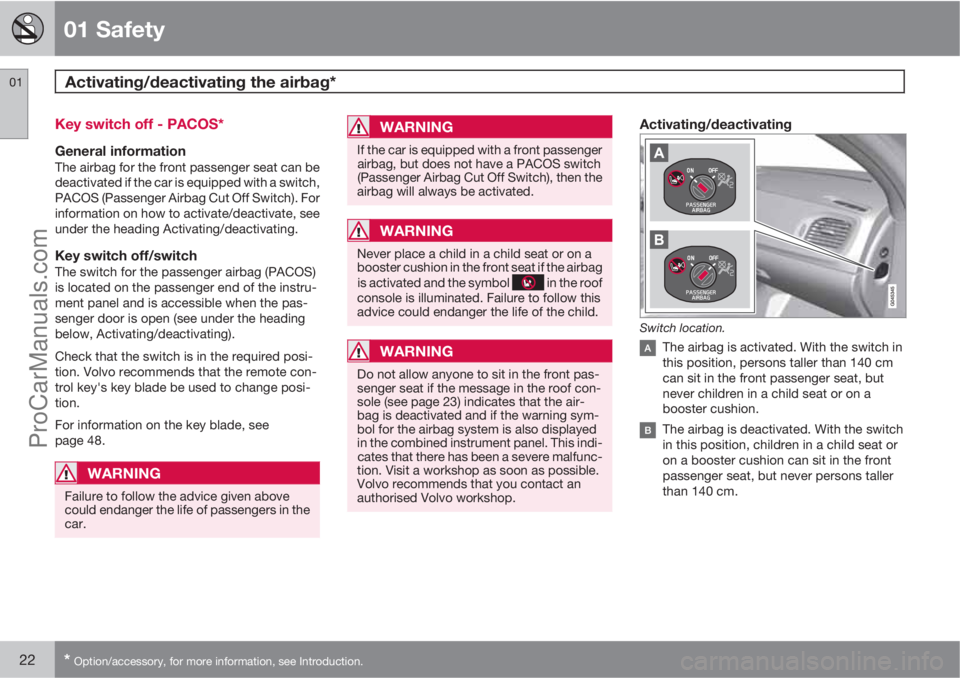
01 Safety
Activating/deactivating the airbag* 01
22* Option/accessory, for more information, see Introduction.
Key switch off - PACOS*
General informationThe airbag for the front passenger seat can be
deactivated if the car is equipped with a switch,
PACOS (Passenger Airbag Cut Off Switch). For
information on how to activate/deactivate, see
under the heading Activating/deactivating.
Key switch off/switchThe switch for the passenger airbag (PACOS)
is located on the passenger end of the instru-
ment panel and is accessible when the pas-
senger door is open (see under the heading
below, Activating/deactivating).
Check that the switch is in the required posi-
tion. Volvo recommends that the remote con-
trol key's key blade be used to change posi-
tion.
For information on the key blade, see
page 48.
WARNING
Failure to follow the advice given above
could endanger the life of passengers in the
car.
WARNING
If the car is equipped with a front passenger
airbag, but does not have a PACOS switch
(Passenger Airbag Cut Off Switch), then the
airbag will always be activated.
WARNING
Never place a child in a child seat or on a
booster cushion in the front seat if the airbag
is activated and the symbol
in the roof
console is illuminated. Failure to follow this
advice could endanger the life of the child.
WARNING
Do not allow anyone to sit in the front pas-
senger seat if the message in the roof con-
sole (see page 23) indicates that the air-
bag is deactivated and if the warning sym-
bol for the airbag system is also displayed
in the combined instrument panel. This indi-
cates that there has been a severe malfunc-
tion. Visit a workshop as soon as possible.
Volvo recommends that you contact an
authorised Volvo workshop.
Activating/deactivating
Switch location.
The airbag is activated. With the switch in
this position, persons taller than 140 cm
can sit in the front passenger seat, but
never children in a child seat or on a
booster cushion.
The airbag is deactivated. With the switch
in this position, children in a child seat or
on a booster cushion can sit in the front
passenger seat, but never persons taller
than 140 cm.
ProCarManuals.com
Page 25 of 422
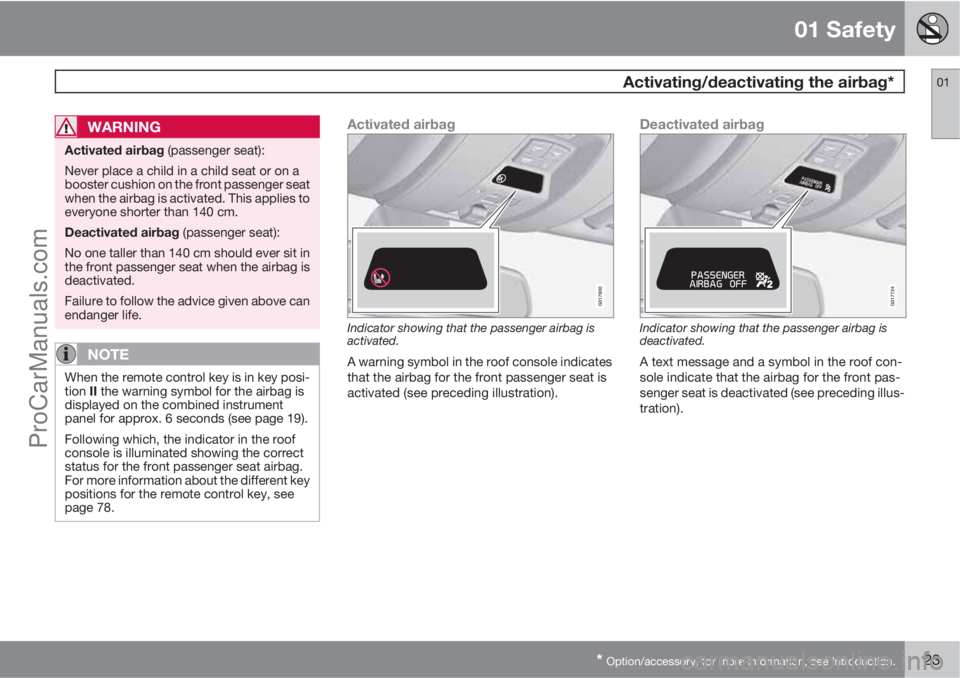
01 Safety
Activating/deactivating the airbag*01
* Option/accessory, for more information, see Introduction.23
WARNING
Activated airbag (passenger seat):
Never place a child in a child seat or on a
booster cushion on the front passenger seat
when the airbag is activated. This applies to
everyone shorter than 140 cm.
Deactivated airbag (passenger seat):
No one taller than 140 cm should ever sit in
the front passenger seat when the airbag is
deactivated.
Failure to follow the advice given above can
endanger life.
NOTE
When the remote control key is in key posi-
tion II the warning symbol for the airbag is
displayed on the combined instrument
panel for approx. 6 seconds (see page 19).
Following which, the indicator in the roof
console is illuminated showing the correct
status for the front passenger seat airbag.
For more information about the different key
positions for the remote control key, see
page 78.
Activated airbag
G017800
Indicator showing that the passenger airbag is
activated.
A warning symbol in the roof console indicates
that the airbag for the front passenger seat is
activated (see preceding illustration).
Deactivated airbag
2
2
G017724
Indicator showing that the passenger airbag is
deactivated.
A text message and a symbol in the roof con-
sole indicate that the airbag for the front pas-
senger seat is deactivated (see preceding illus-
tration).
ProCarManuals.com
Page 26 of 422
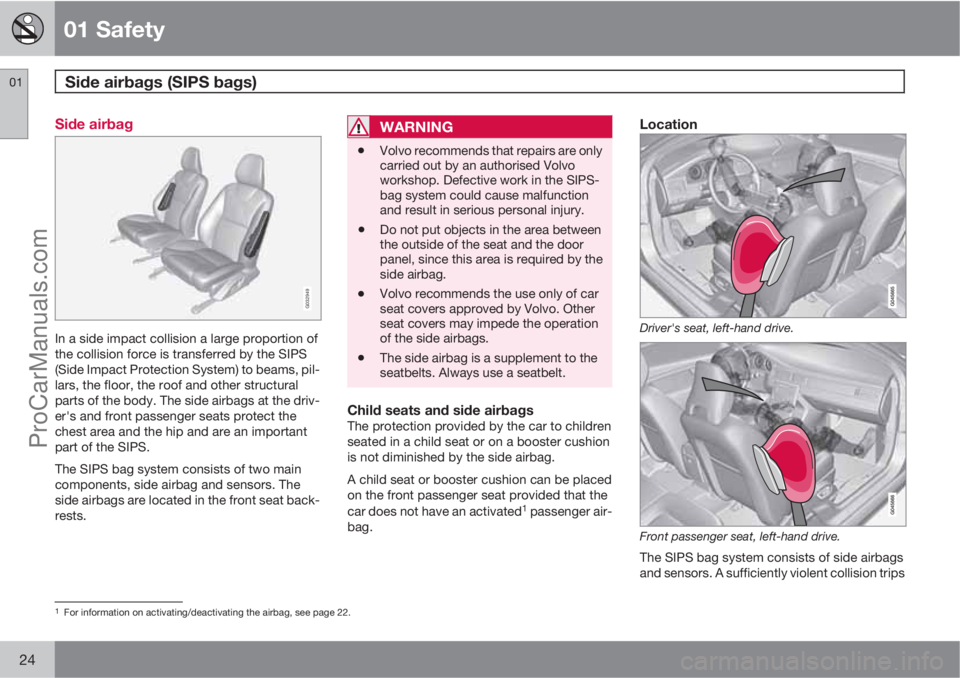
01 Safety
Side airbags (SIPS bags) 01
24
Side airbag
G032949
In a side impact collision a large proportion of
the collision force is transferred by the SIPS
(Side Impact Protection System) to beams, pil-
lars, the floor, the roof and other structural
parts of the body. The side airbags at the driv-
er's and front passenger seats protect the
chest area and the hip and are an important
part of the SIPS.
The SIPS bag system consists of two main
components, side airbag and sensors. The
side airbags are located in the front seat back-
rests.
WARNING
•Volvo recommends that repairs are only
carried out by an authorised Volvo
workshop. Defective work in the SIPS-
bag system could cause malfunction
and result in serious personal injury.
•Do not put objects in the area between
the outside of the seat and the door
panel, since this area is required by the
side airbag.
•Volvo recommends the use only of car
seat covers approved by Volvo. Other
seat covers may impede the operation
of the side airbags.
•The side airbag is a supplement to the
seatbelts. Always use a seatbelt.
Child seats and side airbagsThe protection provided by the car to children
seated in a child seat or on a booster cushion
is not diminished by the side airbag.
A child seat or booster cushion can be placed
on the front passenger seat provided that the
car does not have an activated
1 passenger air-
bag.
Location
Driver's seat, left-hand drive.
Front passenger seat, left-hand drive.
The SIPS bag system consists of side airbags
and sensors. A sufficiently violent collision trips
1For information on activating/deactivating the airbag, see page 22.
ProCarManuals.com
Page 27 of 422
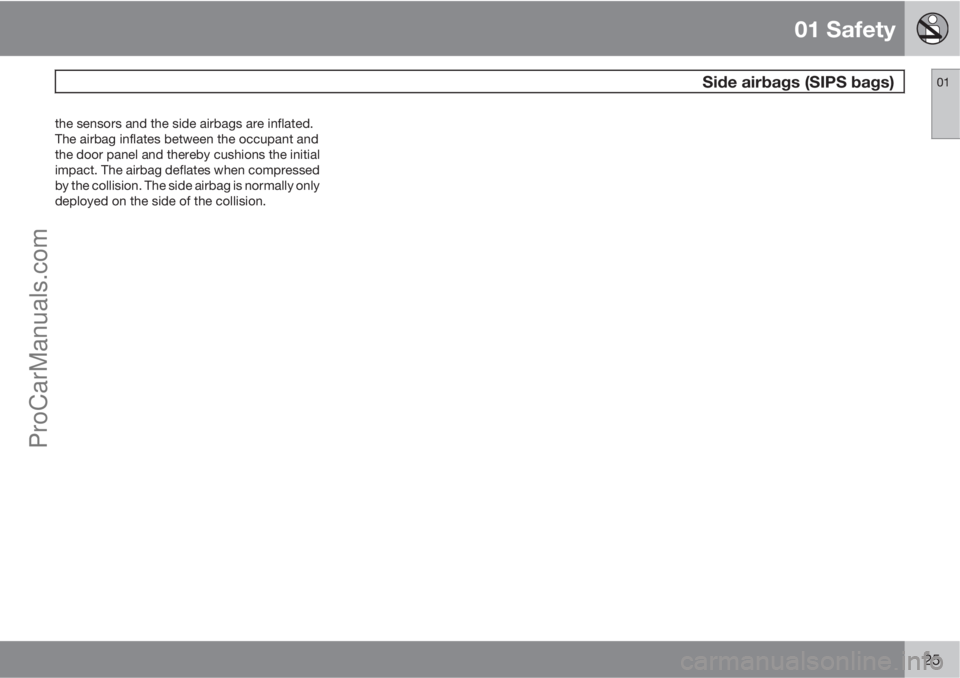
01 Safety
Side airbags (SIPS bags)01
25
the sensors and the side airbags are inflated.
The airbag inflates between the occupant and
the door panel and thereby cushions the initial
impact. The airbag deflates when compressed
by the collision. The side airbag is normally only
deployed on the side of the collision.
ProCarManuals.com